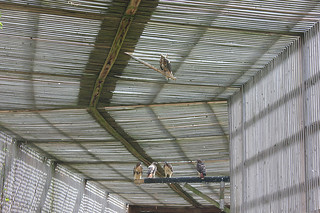Southeastern Raptor Center to hold public bird release Saturday morning in Opelika
Article body
The Southeastern Raptor Center at Auburn University’s College of Veterinary Medicine will hold a public release of rehabilitated birds on Saturday, Oct. 11, at 8:45 a.m. in Wood Duck Heritage Preserve and Siddique Nature Park in Opelika. Opelika Mayor Gary Fuller will attend the event.
Elizabeth Crandall, the assistant director of rehabilitation at the center, said two to four birds will be released. The decision on which birds to release will be made Friday after a performance test to evaluate the birds’ maneuverability, tail and wing feather durability, landing ability, vertical lift – how high the birds can get off the ground, endurance and symmetry – the ability to use their body in proportion. Crandall said these tests will ensure that the birds are aptly prepared to return to their chosen habitat.
Crandall said once the birds are released, there is no way to predict where they will go. “Some of them will establish territory locally in the wooded areas in Auburn and Opelika, and some may go as far as 1,000 miles away,” she said.
This is the first time that the Southeastern Raptor Center has released birds in Wood Duck Heritage Preserve and Siddique Nature Park and faculty and staff are excited about the opportunity. The center has 70 volunteers this semester who assist the full time staff in the care and management of the animals and the facility and some of those volunteers will help release the birds at the event. Crandall said it’s the center’s way of saying “thank you” for their support and devotion to the animals housed there.
Hundreds of birds are brought to the center each year for rehabilitation and treatment and are treated for ailments ranging from malnutrition to fractures.
Not all of the birds recovering at the center can be released. Some have terminal injuries or ailments that prevent them from returning to the wild. They will either remain at the center and used to educate students and the general public about raptors or transferred to another educational facility.
In addition to providing rehabilitation and education, the Southeastern Raptor Center is the home of War Eagle VII, the golden eagle known as Nova, and Spirit, an American bald eagle, who fly during the pre-game ceremony in Jordan-Hare Stadium during every home football game.
The Southeastern Raptor Center has been in operation since the mid-1970s, when the U.S. Fish and Wildlife Service brought in six injured birds to the College of Veterinary Medicine. The mission of the center is education, rehabilitation and conservation.
For more information about the Southeastern Raptor Center, go to: www.auburn.edu/raptor.
Information and driving directions for Wood Duck Heritage Preserve and Siddique Nature Park:
For more information about Wood Duck Heritage Preserve and Siddique Nature Park online, go to http://www.alabamabirdingtrails.com/sites/opelika-wood-duck-heritage-preserve-and-siddique-nature-park/. Driving directions: from the intersection of US 280 and CR 97, Grand National Parkway, travel east on US 280 .6 mile and turn left onto Waverly Parkway. Travel .5 mile to entrance of park on left. Driveway entrance is between two sections of split rail fence; continue on Waverly Parkway another .1 mile to the roadway entrance of the Preserve.Related Media
Media interested in this story can contact Communications Director Preston Sparks at (334) 844-9999 or preston.sparks@auburn.edu.
Auburn University is a nationally ranked land grant institution recognized for its commitment to world-class scholarship, interdisciplinary research with an elite, top-tier Carnegie R1 classification, life-changing outreach with Carnegie’s Community Engagement designation and an undergraduate education experience second to none. Auburn is home to more than 30,000 students, and its faculty and research partners collaborate to develop and deliver meaningful scholarship, science and technology-based advancements that meet pressing regional, national and global needs. Auburn’s commitment to active student engagement, professional success and public/private partnership drives a growing reputation for outreach and extension that delivers broad economic, health and societal impact.






